The Joy of Misery
Timpanogos Direct West - South Gully Variation
"Because it's there."
That's the answer George Mallory gave when asked why he wanted to climb Everest.
But Everest was clear on the other side of the world minding its own business. It never asked to be climbed. It didn't taunt people every day on their morning and afternoon commute, reminding them that they had just spent another day of their short lives indoors, on the phone, on the computer, and not on their skis or bike or sailboat doing whatever makes life most beautiful.
Mount Timpanogos is
that kind of mountain. It rises abruptly from Utah Valley's 4,500' floor to a towering 11,750' above sea level. The valley's 400,000+ residents can't avoid seeing it any day they step out their front doors. The mountain's steep ridges catch the morning sun and make you feel like you live in a postcard every time you look up. They remind you that you live in a box every time you look down.
Just don't mistake Timpanogos' ceaseless taunting for a casual invitation to climb it. It's steep, it's tall, it's full of cliffs and loose, broken rock, and the air gets a bit thin near 12,000'. Its soaring flanks collect upwards of forty feet of snow blown into teetering cornices atop airy cliffs and pounded deep into steep ravines by frequently-violent avalanches.
Thousands of hikers ascend relatively comfortable trails up the east (back) side in summer months, but for the most part not until the snow has stopped breaking apart and sweeping down the mountain.
On the other hand, the snow makes an ascent up the west (front) side possible, covering the loose cliffs and providing access that quickly vanishes with summer's approach. Several routes lead to the summit ridge, but having tried most of the easier routes, I invited a few friends to climb the Direct West Ridge in mid-May 2006.
In the days before our scheduled ascent, the snow peeled away from the ridge and the friends backed away from the trip. The next best thing to climbing a mountain with friends is climbing one alone, so I left Saturday morning and started up Battle Creek Canyon (Pleasant Grove 1700 East 200 South) intending to at least get part way up the mountain in order to report on conditions for a rescheduled trip. If it didn't happen soon, it would have to wait till next year.
I paused momentarily at each of the numerous scenic waterfalls in Battle Creek Canyon, catching a bit of refreshing spray where possible, wishing to experience the beauty of it deeply but knowing that would only come with more time and exertion.
Beauty is internal, after all. There's no such thing as beauty in the external world. There's color, contrast, harmony, size, shape and symmetry, but beauty only happens when those elements strike a chord inside you. The experience of beauty is purely subjective.
Sometimes you have to quiet the noise inside before you're able to perceive beauty. When it finally happens, when your heart and mind recognize their own beauty reflected in the external trigger, it's yourself that you actually experience, not the object you saw. The beauty you found was entirely contained inside the judgment you passed on the external world. The things you find beautiful tell a lot about the being living inside your skull and between your ribs.
Soon I reached the sprawling meadows of Sagebrush Flats and the trail intersected the Great Western Trail. I turned south toward Baldy, crossed a large drainage, and reached the gully to the south of the Direct ridge. This was my chosen route. The snow field ended a hundred feet down the ravine and stretched all the way to the mountain tip. I had hiked up 3,000', only 5,000' more to go.
After donning my mountaineering boots and crampons and kicking my way up the hard snow to the first bend in the gully, I checked the elevation on my GPS and found that I had already climbed a hundred feet. "1 down, 49 to go," I thought, and continued marking my progress in hundred foot segments for the rest of the climb.
As I rounded the corner, an enormous side wall showed evidence of where avalanches had rushed down from high on the mountain and scoured away the vegetation and dirt. This barren expanse of dirt and rock spoke of dramatic force and power. I imagined the white tidal wave of snow barreling around this curve like the Polar Express on a frothy luge run. Something about the image struck a chord inside and I experienced the first glimmer of the beauty I sought.
I continued counting in hundreds of feet past the first two cliff bands, complete with snowmelt waterfalls spilling over the brink. The snow remained solid underneath with several soft inches on the surface that made kicking steps relatively easy.
When the slope grew steep after the second cliff band, I found myself slowing considerably. I should have eaten a big meal that morning and the night before, so now I had to pause occasionally to down granola bars, trail mix and jerky, then kick my way up slowly while waiting for the energy to kick in. I felt tired, but I knew it wasn't the serious kind of tired because if I paused momentarily after every dozen steps, then I felt just as strong as I had twenty or thirty steps ago.
I thought about turning back, but couldn't let myself do it just because of a little fatigue. In the first place, my friends would ask how far I made it, and I didn't want to admit to only 9,000'. In the second place, I didn't want to squander my weekend. If I turned back now, I'd regret it later, and later would arrive well before the sun set. In the third place...I didn't feel very good and didn't want to turn around until I had begun to feel better.
The truth was that I had been mildly depressed for a while now. Something inside had gotten stuck and I hadn't been able to jar it loose the way I usually could with a little effort. I didn't even know how to describe it. It was like pain or ugliness and it left a bitter taste inside and some sort of weight that prevented me from feeling as good as I wanted and accomplishing everything on my long do list.
I didn't know the source of the depression and had given up trying to track it down. All I knew is that emotion is chemical based, that tiny strings of amino acids called peptides bond with cell receptors and make us feel. Imagine your cells with taste buds and each emotion as its own flavor.
All sorts of things can throw your chemistry off balance - like illness, injury, stress, inadequate sleep and exercise, poor appetite, and even limiting beliefs and negative perceptions, just to name a few. All these either place undue demands on the body's limited resources or fail to replenish them. Once things get off kilter, you just don't feel good.
I suddenly grew aware of a quirky belief that had been floating in the back of my mind - that if I could push myself through enough physical discomfort, then I would break free. It reminded me of my friend Rod who had discovered the Joy of Misery while trekking through Germany. He was sitting at a bus stop one night in the pouring rain. The bus was hours overdue and he didn't know if it would even show up and what would happen if he had to spend all night outside. Cold rain ran down his scalp and down his neck. Then something snapped.
At this point in the story, Rod paused, and a look of supreme contentment fell across on his face like the morning sun pouring slowly into a valley. "What?" I asked.
"Clarity," he replied. "Bliss."
It was internal. It was chemical. When his body could stand no more misery, endorphins released and erased all discomfort and pain. They lifted him above all fear, doubt, and limitation. He stood balanced on top of the world where there are no limits. For the moment, Rod experienced the ultimate freedom. Nothing external had changed, but remember - we don't experience the world, we experience only ourselves. Perception is the most powerful reality.
Ever since that transcendent moment, Rod had set off in search of misery. He wanted to recapture that clarity and freedom again. I tried to persuade him that his quest was ridiculous, that misery is not the only, nor the best, place to discover joy; but I have to admire his dedication and his willingness to suffer.
After all, willingness to suffer is what spells the difference between a glorious life and a mediocre or downright disappointing one. It's not uncommon to have a dream of how you'd like your life to turn out, but it's rare for someone to willingly push through all the requisite misery to turn that dream into reality. Sometimes there's no way around the suffering. Sometimes you just have to go through.
No, I would not turn back yet. I would push on until it worked, I told myself, until I felt better; at least to 10,000', which I estimated to be around the next cliff band and waterfall. I would continue on simply because I could, and because I had nothing more important to do.
I reached the cliff and scaled a section where it protruded about fifteen feet from the snow below, hooking my axe on sharp, blocky edges and high stepping my crampons to wide ledges. I had emptied my water bladder and took a minute to refill it from the runoff, unconcerned about giardia in so much snowmelt and where so few rodents might live below the snow in such a steep, rocky area.
The stream exited from beneath the snow and tumbled over tiny falls for nearly thirty feet before splashing over the brink. The crystal white noise was perfectly calming, refreshing, and relaxing. Its vibrations seemed to travel through my muscles and bones and began to induce a peace and calm that I hadn't experienced for weeks. I wondered if I should spend half an hour here and then just head home. But as soon as I had repacked the bladder inside my pack, the urgent press of things to do and places to go weighed in again on my mind, and I could no longer continue to relax and enjoy the moment. The snowpack was warming, avalanche danger would begin to rise soon, and I couldn't stick around forever.
I glanced upward and saw three people walking along the summit ridge. I was surprised at how close they seemed. Usually 1,750' of elevation gain in the mountains puts the distance at at least a mile. On these steep slopes, they stood only three or four football fields away.
I had climbed over 6,250 feet. 33 of 50 hundred foot units since leaving the trail. With the summit so near, why turn back? The break had refreshed me, the slope angle had relaxed slightly, and I had plenty of strength left. I checked my GPS, guessed where 11,000' fell along the route above, and started upward again.
Despite my optimistic determination, the climb mostly felt like a lot of miserable work. The going was steep and sustained and I was tiring and slowing down a little. Not only that, but the physical misery was not having the desired effect on the emotional misery. Quite the opposite. The two seemed to blend and accentuate each other.
I rounded the corner of an 80' cliff and started up the steepest section yet. It felt like 70 or 80 degrees. Another week or so and this route would turn impossible. It would expose the rock below - loose, broken limestone that would support little weight and release any protection if so much as touched by the breeze.
I reached a cliff and began making my way up next to it. The snow turned soft and airy. With each step I took, the snow collapsed four feet and left me buried to my waist.
I tried moving away from the rock where the radiant heat from the sun-drenched rock may not have transformed the snow so much, but found conditions there equally problematic. I had carefully avoided choosing a route that placed me over a cliff. That was so that if the snow did happen to break loose and sweep me down the mountain, at least I wouldn't have a vertical fall to break my bones before applying a deadly cold pack over me. I finally moved back to the rock edge and held on for security while climbing the next forty feet and passed 11,000'. The snow didn't seem prone to slide, but I kept a nervous eye on it.
Almost there. Forty three down, seven to go.
When the cliff ran out, I looked up again. What I found was an even steeper slope, stretching up for about a hundred feet. I suddenly missed the security of rock hand holds.
From the valley I had only seen a continuous snow path to the summit and knew that I could make it. I hadn't counted on a slope that would make me question whether I should be there. If the snow density didn't improve, I would either choose another way up or go back down. Turning back would be difficult having come so close to the top, but I would do it if necessary.
I gripped my axe shaft and swung the adze into the snowpack. I jammed one mittened hand in deep for added support. I stepped upward away from the cliff and kicked my foot in deep. Slowly, I transferred my weight to that boot and tested the snow's stability. It held. I moved up a step and slowly repeated the process. Again my foot supported my weight. I took a few more steps with similar results and was relieved to find that the snow remained more solid than along the cliff below. Even so, I moved slowly and carefully until I passed a minor breakover where the angle sloped off ever so slightly.
Glancing back downhill, my tracks appeared even more vertical than the route had seemed on the way up. It was then that I realized that this section would become an exposed vertical cliff within days or weeks. The sun would heat the exposed rocks and melt the adjacent snow. At some point it would slide and anything it had been supporting above would fall with it.
My camera lens had water drops from bouncing against the snow with nearly every step, but I didn't bother to wipe it off just yet. I noted that I could have traversed around to the north three or four hundred feet ago and had a much more gentle slope to climb, but that would have put me above a hundred foot cliff. Now that the hardest part was nearly over, I was glad I had chosen this route. I glanced up, and the red tip of the summit hut appeared on the horizon.
Despite seeming so close, the last several hundred feet to the summit were long and tiring. The snow was too soft and deep away from the rocks that had melted through areas of the ridge, but walking across the loose, broken surfaces in crampons was uncomfortable and tiring. I finally settled for walking a few feet from the rocks where the snow stabilized my footing but I didn't posthole so deep.
At last I reached the more stable rock that caps Timpanogos and protects the summit ridge from rapid erosion. I removed my crampons and climbed the final stair-like feet to the summit hut.
I sat down on a rock and let my pack fall off my back. I leaned forward and stretched the muscles in my lower back. It felt good to work out the slight soreness there, but overall, I still felt the same miserable yuckiness inside.
I knew better than to expect elation just for reaching a beautiful mountain peak. I learned better on the top of the Grand Teton years ago. In the months leading up to that expedition, I often wished aloud that it was 35' higher to make it the highest peak in the range instead of the remote Gannet Peak. When we reached the 13,770' summit after climbing the full Exxum Ridge, I had a splitting headache from dehydration and said "It's high enough."
The view looking down at Lupine Meadows was stunning, but I may have enjoyed the climb most from the highway on the drive home. I suddenly realized how thick normal air felt in my throat and lungs. I could take a long drink of water or say a long sentence without having to catch my breath in the thin air. In retrospect, even the discomfort of climbing with numb fingertips before sunrise and stumbling back into camp in the moraine in the dark were beautiful moments. Hindsight is 20/40 and I wouldn't have it any other way.
Now came the next decision. Would I head back down the west slope, or drop down to the east and hitch a ride back to my car? The snow was getting soft to the west, while the east was now largely in the shade. Regardless, I wouldn't follow my tracks back down. Either way, I would decend from the same point along the summit ridge - the glacier saddle - about half a mile to the south.
As I worked my way along the ridge, I glanced down at the Emerald Lake basin and got an idea. next to the frozen lake was the hut. It was a steel-roofed rock and cement structure with no door. If I had been a cartoon, a light bulb would have illuminated above my head. I could stay there tonight. After all, I was tired. If I went home tonight, it would just be another night. I'd turn in early and rest up. It wouldn't count for anything.
But if I stayed in the hut...that might be something. I could sit back and just think for a while. Ponder something. Anything. It would buy me another dozen hours in prime, beautiful nature, and that would make a difference, too. I wouldn't be comfortable, though. I hadn't brought a sleeping bag or pad. It wouldn't be warm inside the large stone room. But I would survive. I wouldn't risk hypothermia or frostbite. The weather just wasn't that cold, even above 10,000'.
As I crossed one of several icy snowfields on the traverse south, I found my first clue as to why I had felt so miserable lately. I was setting my axe shaft in the snow, kicking two steps, then resetting the axe, when I looked down. Forty feet below me, the snow ran out and a narrow space of loose rock sat across a fifty foot cliff. This was not a "normal" place to be. This was not safe for the average hiker nor terribly comfortable even for myself. Yet here I went crossing it with confidence, without a second thought. Something in that recognition felt good, though I wouldn't finish assembling the puzzle for several hours.
![The next racer is in the gates...]()
When I reached the saddle, I looked down the west slope. It may have just been the lowering angle of the sunlight spreading across the slopes and highlighting the contrast of old avalanches, but it looked like new slides had crossed my path behind me. Certainly there were several wet point releases that had slid during the afternoon. Then I looked north east toward the hut and made my decision.
Five-foot tall chunks of cornice had recently rolled down the slope without loosening the snowpack and I felt perfectly safe. I took my shovel off my pack, sat down on it, lifted my feet and began a wild ride toward my soon-to-be home sweet hut.
This cirque is known as "the glacier." It's not a true glacier, though many will claim otherwise, because the snowpack doesn't move and scrape the bed surface along with it. It's just a permanent snowfield, but the name sticks and makes a summer trip up Timp sound that much more exotic to anyone who doesn't know the difference.
The slope evened out and I walked down, examining the crust as I went and seeking the hardest snow where I wouldn't break through. I heard a noise like the roar of a jet plane buzzing the summit and knew what was happening. I looked up and watched for over a minute as millions of gallons of snow spilled over the cliffs from the summit. It was only a medium-sized avalanche, but still powerful and unstoppable and beautiful.
I reached the hut and found less than two feet of it protruding from the snow. I dug down to the doorway, then jumped into my hole to check out the conditions inside. Snow had drifted through the open door and a broken window pane and piled four to six feet deep throughout the single room. In other words, it wasn't too bad and I'd be okay.
I climbed back outside and walked east to where I picked up cell reception from Heber City. I dialed the friends I had spoken to about possibly giving me a ride back around the mountain and told them not to worry about it for the night. I didn't want them getting nervous and sending Search and Rescue out looking for me. The sky grew pink and held my attention for several minutes before I climbed back inside, sealed off the doorway, and began digging out my rock bunk.
At first I just scraped off an area of the stone bench lining the walls plus a place for my feet when I sat up, but that was too narrow. Later I dug out a wider space on the floor, and hours later, after tossing and turning and shivering, I dug out a "snow cave" space to see if that would trap any additional heat.
With no pad, I emptied the contents of my pack and slept on that. With no sleeping bag, I was glad to find an emergency foil blanket which kept me considerably warmer. The foil didn't breathe, though, and all my body's moisture condensed against it. Between that and sometimes letting my jacket touch the wet floor, I was lucky to be aware enough not to have worn any cotton. Cotton draws heat away from your body when wet which has earned it the moniker "killer cloth." My fleece, nylon and shells stayed relatively warm despite the water.
I used a boot for a pillow and unhooked the backpack's shoulder straps to cushion the hard sole. I put on the running shoes I had worn on the approach and a pair of dry socks. When the foil tore as I tossed and turned and tried to keep it tucked under me, I put a torn piece and wore it inside my shoe which seemed to help warm my feet up. I woke up shivering at least every hour - surprised to have slept so long - and ate more trail mix and jerky and candy to warm me for a while longer.
![Buried Alive!]()
There was no room in my head for clarity. No free space between the discomfort to think or ponder anything, but an epiphany found me just the same. As I curled tighter and lay my arms along my sides to reduce surface area and heat loss, at one point I noticed my thigh muscle and suddenly remembered how good it feels just to have a body. Just to have muscles and motion. To run and hike and swim or just sit in the shade and breathe. To feel the wind and rain and snow and the sun splashing across your upturned face.
With that recollection, the last puzzle piece slid into place and I knew what had made me miserable lately. I had been living life much as I had endured this weekend's climb. In all my hustle and bustle, hurry and worry of working and achieving and reaching deadlines and never stopping and never giving up, I had neglected myself. I hadn't stopped to notice how much I had cut back on outings and
adventures like this weekend's. I had worked and reached goal after goal with only brief respite. As VP of Customer Success for a rapidly growing and innovative
company poised to make significant contributions to healthcare and medical paradigms, our recent software and hardware releases had meant an endless list of training materials to build and customer questions to answer. In my spare time, my position on the local
Search and Rescue team and other duties and projects left little time for relaxing. I pushed forward without looking down and accepted all this inertia much the way I was accepting this miserable, wet, cold, lumpy night in the Emerald Lake Lodge - hardly noticing the discomfort, barely complaining, simply accepting that this had to be endured.
The neglect included failing to run up the canyon as often as I used to. I came home tired and let excuses like a too-cool spring or 90%-healed injured foot keep me inside working instead. I ate mostly fast food and quick snacks. I often stayed up late, woke up early, and didn't stop moving all day long. All this had taken its toll.
The seeds of solution lie within every problem. All I needed to do was pay more attention to myself. Take a little better care of my body. Enjoy being alive. Come to a full stop and look around from time to time. I clung to the memory of being more alive and observed the old, deep misery melting away.
By 06:00, there was no use trying to sleep further. I stood up and rocked back and forth, bouncing slightly and twisting back and forth to generate heat. By 06:30, the sky had grown lighter, which I watched through the double corrugated fiberglass above the door. As the sun rose, I thought I detected some red hue in the sky, but didn't want to dig out the doorway to see. I was cold and wet and wearing running shoes and could afford to miss one glorious sunrise.
Around 06:45, I packed my drenched belongings back into my soaking wet pack and dug my way out of the hut. The outside air felt warm in the morning sun. I spread out my gear on the roof to dry while I took a short walk around on the frozen crust. Then I slipped my boots and crampons back on and headed east down the mountain.
Somewhere just below the breakover where the Primrose Cirque dives over 3,000 feet to the Aspen Grove trailhead lay a snowshoer, buried since a New Year's Eve afternoon avalanche fractured just above him and swept him and a friend down the mountain. The Utah Avalanche Center (
http://www.avalanche.org/~uac) had reported extreme avalanche danger that day due to high snowfall that had not yet had time to bond to previous snow layers, but many hikers are unaware of this invaluable resource and the complex science of avalanche forecasting and winter travel.
The survivor managed to stay on top of the slide, and he never saw his friend again. He searched frantically for fifteen minutes, then dialed 911. Search and Rescue was paged out and they rushed to the trailhead below. Sheriff Sergeant Tom Hodgson spoke with the survivor on his cell phone and tried to persuade him to stay put rather than risk death by descending through literally hundreds of potential avalanche starting zones, but to no avail.
A Life Flight helicopter stood by, waiting for a break in the weather, ready to carry me and SAR Mountain Rescue Team Sergeant Bruce Riddle to the hut where we could guide the survivor back and care for him until weather permitted evacuation, but there was no convincing him to stay put in the frozen morgue. He slid his way down the mountain without his snowshoes (which he left to mark the area) until a Division of Public Safety helicopter was able to pick him up a mile from the parking lot.
Until now, an extended spring with endless snow storms had made recovery efforts too dangerous to attempt. I surveyed the area, wondering where our teams would search first, and whether the high probability areas would pay off or if we'd be forced to wait till 40' deep piles of snow melted away.
"Living it up" in the great outdoors requires a delicate balance between training and experience, informed risk and judicious caution.
I removed my crampons in preparation for my glissade down the cirque. Last July 4 we climbed nearly this high to retrieve a climber who had glissaded with his crampons on and broken his tib/fib as a result.
I sat on my shovel, axe in hand, and lifted my heels from the snow. I instantly took off fast, snow splashed two feet into the air like class IV whitewater, and I considered digging in my axe to slow my descent, but quickly decided that I'd be fine. The top several inches of snow were soft and loose. I bounced into the air over bumps and landed soft and kept right on going. It was the most beautiful thing I had done in recent memory.
I finally dug in my axe and stopped before the first cliff band, then traversed around to the side and started again. I occasionally had to dodge rocks and fissures or downclimb cliff bands, carefully avoiding the shallow snow over running water, but I made quick progress and soon found myself walking down the paved trail below First Falls. I called the friend who had promised to pick me up and she arrived at the trail head just as I had changed my shoes and started walking down the road.
At home, I pulled a blanket onto the carpeted floor and fell asleep. I had no idea how comfortable a floor could be.
Now, a few days later, I sit on my front steps with my pleasantly sore muscles and stare up at Mount Timpanogos, remembering the opposite view from on top staring down. I live in a postcard. I'm living an action/adventure movie. All the misery of the climb is gone and the joy that can only follow suffering will continue to grow.


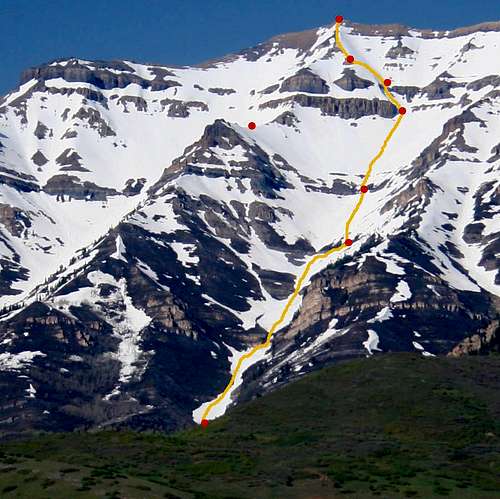
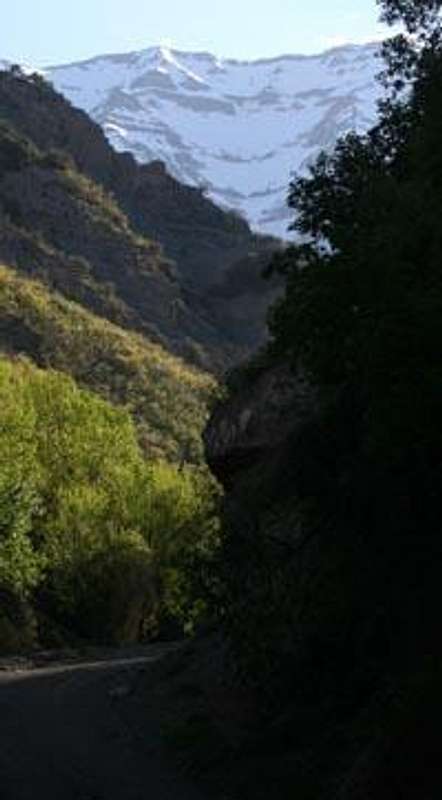
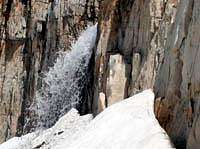

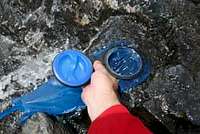




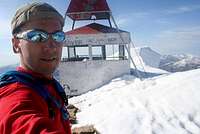
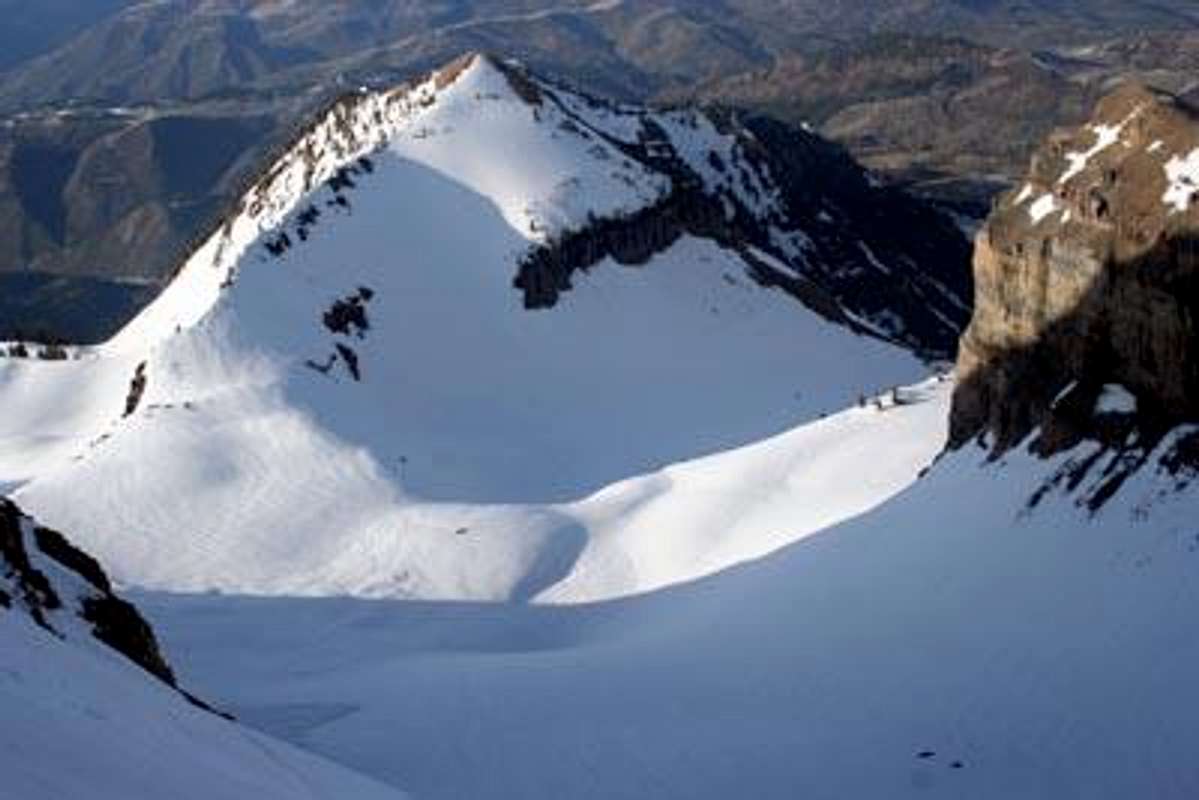















Comments
Post a Comment